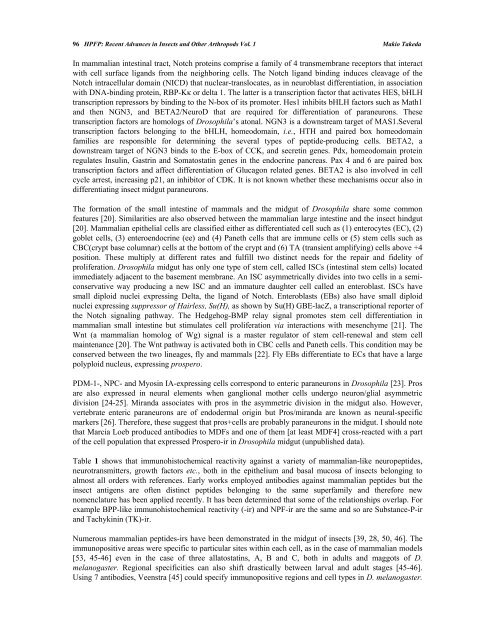chapter 1 - Bentham Science
chapter 1 - Bentham Science
chapter 1 - Bentham Science
Create successful ePaper yourself
Turn your PDF publications into a flip-book with our unique Google optimized e-Paper software.
96 HPFP: Recent Advances in Insects and Other Arthropods Vol. 1 Makio Takeda<br />
In mammalian intestinal tract, Notch proteins comprise a family of 4 transmembrane receptors that interact<br />
with cell surface ligands from the neighboring cells. The Notch ligand binding induces cleavage of the<br />
Notch intracellular domain (NICD) that nuclear-translocates, as in neuroblast differentiation, in association<br />
with DNA-binding protein, RBP-Kκ or delta 1. The latter is a transcription factor that activates HES, bHLH<br />
transcription repressors by binding to the N-box of its promoter. Hes1 inhibits bHLH factors such as Math1<br />
and then NGN3, and BETA2/NeuroD that are required for differentiation of paraneurons. These<br />
transcription factors are homologs of Drosophila’s atonal. NGN3 is a downstream target of MAS1.Several<br />
transcription factors belonging to the bHLH, homeodomain, i.e., HTH and paired box homeodomain<br />
families are responsible for determining the several types of peptide-producing cells. BETA2, a<br />
downstream target of NGN3 binds to the E-box of CCK, and secretin genes. Pdx, homeodomain protein<br />
regulates Insulin, Gastrin and Somatostatin genes in the endocrine pancreas. Pax 4 and 6 are paired box<br />
transcription factors and affect differentiation of Glucagon related genes. BETA2 is also involved in cell<br />
cycle arrest, increasing p21, an inhibitor of CDK. It is not known whether these mechanisms occur also in<br />
differentiating insect midgut paraneurons.<br />
The formation of the small intestine of mammals and the midgut of Drosophila share some common<br />
features [20]. Similarities are also observed between the mammalian large intestine and the insect hindgut<br />
[20]. Mammalian epithelial cells are classified either as differentiated cell such as (1) enterocytes (EC), (2)<br />
goblet cells, (3) enteroendocrine (ee) and (4) Paneth cells that are immune cells or (5) stem cells such as<br />
CBC(crypt base columnar) cells at the bottom of the crypt and (6) TA (transient amplifying) cells above +4<br />
position. These multiply at different rates and fulfill two distinct needs for the repair and fidelity of<br />
proliferation. Drosophila midgut has only one type of stem cell, called ISCs (intestinal stem cells) located<br />
immediately adjacent to the basement membrane. An ISC asymmetrically divides into two cells in a semiconservative<br />
way producing a new ISC and an immature daughter cell called an enteroblast. ISCs have<br />
small diploid nuclei expressing Delta, the ligand of Notch. Enteroblasts (EBs) also have small diploid<br />
nuclei expressing suppressor of Hairless, Su(H), as shown by Su(H) GBE-lacZ, a transcriptional reporter of<br />
the Notch signaling pathway. The Hedgehog-BMP relay signal promotes stem cell differentiation in<br />
mammalian small intestine but stimulates cell proliferation via interactions with mesenchyme [21]. The<br />
Wnt (a mammalian homolog of Wg) signal is a master regulator of stem cell-renewal and stem cell<br />
maintenance [20]. The Wnt pathway is activated both in CBC cells and Paneth cells. This condition may be<br />
conserved between the two lineages, fly and mammals [22]. Fly EBs differentiate to ECs that have a large<br />
polyploid nucleus, expressing prospero.<br />
PDM-1-, NPC- and Myosin IA-expressing cells correspond to enteric paraneurons in Drosophila [23]. Pros<br />
are also expressed in neural elements when ganglional mother cells undergo neuron/glial asymmetric<br />
division [24-25]. Miranda associates with pros in the asymmetric division in the midgut also. However,<br />
vertebrate enteric paraneurons are of endodermal origin but Pros/miranda are known as neural-specific<br />
markers [26]. Therefore, these suggest that pros+cells are probably paraneurons in the midgut. I should note<br />
that Marcia Loeb produced antibodies to MDFs and one of them [at least MDF4] cross-reacted with a part<br />
of the cell population that expressed Prospero-ir in Drosophila midgut (unpublished data).<br />
Table 1 shows that immunohistochemical reactivity against a variety of mammalian-like neuropeptides,<br />
neurotransmitters, growth factors etc., both in the epithelium and basal mucosa of insects belonging to<br />
almost all orders with references. Early works employed antibodies against mammalian peptides but the<br />
insect antigens are often distinct peptides belonging to the same superfamily and therefore new<br />
nomenclature has been applied recently. It has been determined that some of the relationships overlap. For<br />
example BPP-like immunohistochemical reactivity (-ir) and NPF-ir are the same and so are Substance-P-ir<br />
and Tachykinin (TK)-ir.<br />
Numerous mammalian peptides-irs have been demonstrated in the midgut of insects [39, 28, 50, 46]. The<br />
immunopositive areas were specific to particular sites within each cell, as in the case of mammalian models<br />
[53, 45-46] even in the case of three allatostatins, A, B and C, both in adults and maggots of D.<br />
melanogaster. Regional specificities can also shift drastically between larval and adult stages [45-46].<br />
Using 7 antibodies, Veenstra [45] could specify immunopositive regions and cell types in D. melanogaster.

















